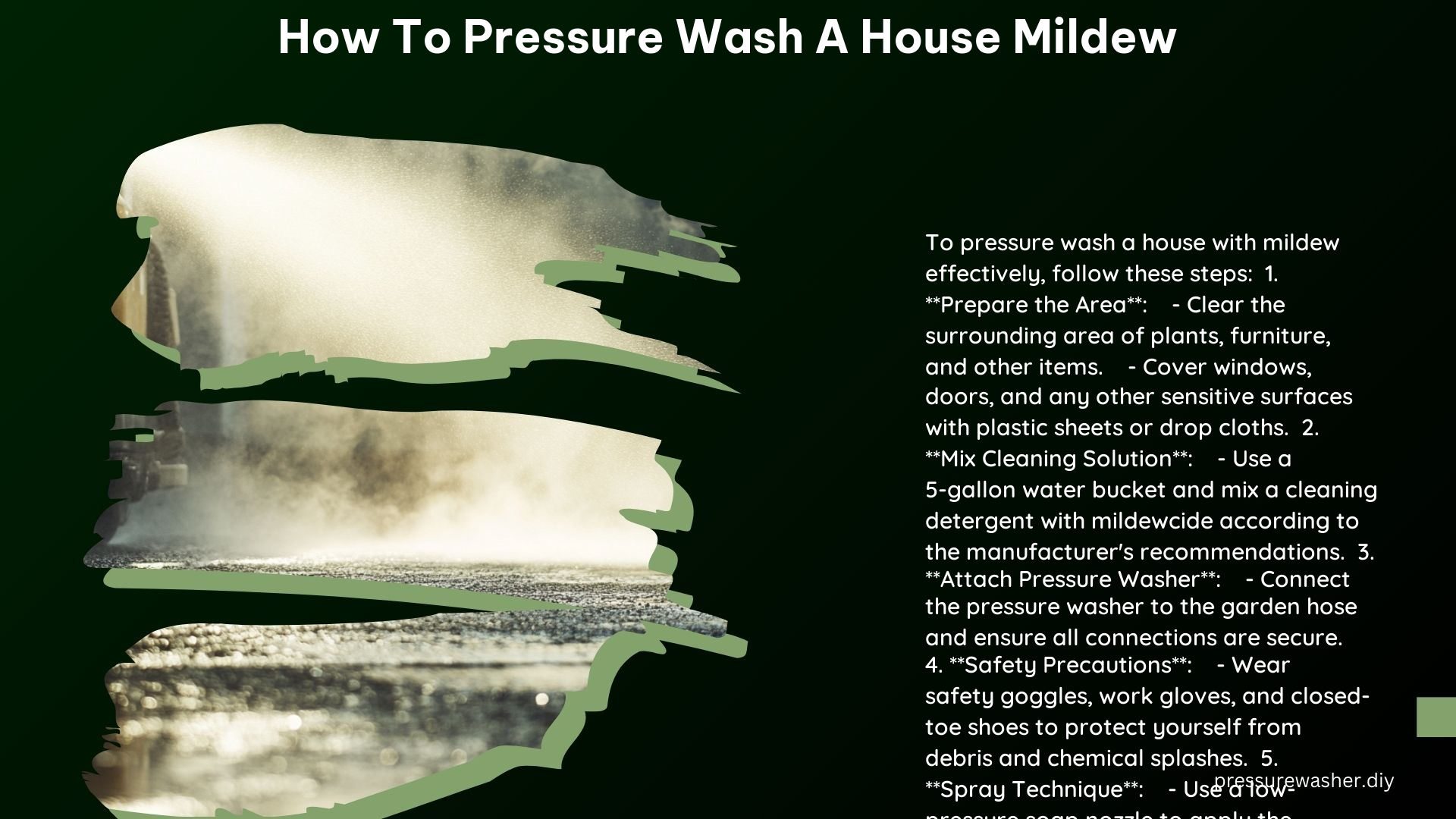Pressure washing is an effective way to remove mildew from the exterior of your house, but it requires careful planning and execution to avoid causing further damage. This comprehensive guide will walk you through the step-by-step process of pressure washing your house to eliminate mildew, while also providing technical details and safety precautions to ensure a successful and efficient outcome.
Prepare the Area
Before you begin pressure washing, it’s crucial to thoroughly prepare the surrounding area. Start by clearing away any plants, furniture, or other items that could be damaged by the pressure washer or cleaning solution. This includes covering windows, doors, and electrical outlets with plastic sheets or drop cloths to protect them from water and cleaning agents.
When selecting the appropriate cleaning solution, it’s important to choose a detergent specifically designed for removing mildew and mold from siding. For vinyl siding, a mixture of bleach and a surfactant like SH or Freshwash is recommended to effectively break down and remove mildew and organic material.
Choose the Right Equipment

The pressure washer you select can make a significant difference in the effectiveness and safety of your mildew removal efforts. Opt for a pressure washer with a low to medium pressure setting, typically ranging from 1,500 to 2,500 PSI. Using a high-pressure setting can potentially damage the siding or force water behind it, leading to further issues like mold growth.
Pair your pressure washer with a wide fan spray nozzle, which will help distribute the cleaning solution evenly and prevent concentrated streams that could cause surface damage. Avoid using a zero-degree nozzle, as it can create a concentrated, high-pressure stream that can easily damage siding or other surfaces.
Mix the Cleaning Solution
When preparing the cleaning solution, follow the manufacturer’s instructions for the appropriate mixing ratio with water. This will ensure the solution is properly diluted and effective in removing mildew. For vinyl siding, a mixture of 1 part bleach to 3 parts water, combined with a surfactant like SH or Freshwash, is a commonly recommended formula.
It’s important to note that the specific cleaning solution and mixing ratio may vary depending on the type of siding on your house. Always test the solution on a small, inconspicuous area before applying it to the entire surface.
Apply the Cleaning Solution
Use a low-pressure soap nozzle to apply the cleaning solution to the siding, starting from the bottom and working your way upwards. This will help prevent streaking and staining. Allow the solution to sit for 5 to 10 minutes, giving it time to penetrate and break down the mildew.
During this time, the cleaning solution will work to loosen and lift the mildew from the surface, making it easier to rinse away. Avoid allowing the solution to dry on the siding, as this can lead to staining or discoloration.
Rinse the Siding
Once the cleaning solution has had time to work, switch to a medium-pressure rinse nozzle to remove the solution and mildew from the siding. Start at the top and work your way down, ensuring a thorough rinse to eliminate any remaining soap residue or mildew.
It’s crucial to maintain a consistent, even rinse pattern to prevent water from pooling or streaking on the siding. This will help prevent any remaining mildew from growing back and ensure a clean, uniform appearance.
Safety Precautions
Throughout the pressure washing process, it’s essential to prioritize safety. Always wear appropriate personal protective equipment (PPE), including safety goggles, gloves, and a face mask, to prevent injury from the pressure washer and cleaning agents.
When working with vinyl siding, be especially cautious and avoid using high-pressure settings, as this can force water behind the siding and cause further damage or mold growth. Instead, opt for a low-pressure setting and a wide fan spray nozzle to gently remove the mildew without compromising the integrity of the siding.
Additional Tips
For wooden decks, use a low-pressure setting with a fan spray nozzle and follow the manufacturer’s recommendations for the specific wood type. Avoid using pressure washers on composite decks, as they can cause damage.
It’s also a good practice to test the pressure washer and cleaning solution on a small, inconspicuous area before applying it to the entire house. This will help you ensure the solution is effective and won’t cause any unintended damage to the siding or surrounding surfaces.
By following these detailed steps and safety precautions, you can effectively remove mildew from your house’s siding using a pressure washer, restoring the clean and vibrant appearance of your home’s exterior.
References:
- Dover Projects. (2009). Cleaning Algae, Mildew and Mold with a Pressure Washer. Retrieved from http://doverprojects.blogspot.com/2009/09/cleaning-algae-mildew-and-mold-with.html
- The Home Depot. (n.d.). How to Pressure Wash a House. Retrieved from https://www.homedepot.com/c/ah/how-to-pressure-wash-a-house/9ba683603be9fa5395fab9017ce6ec7b
- How to with Doc. (2021). Cleaning House Siding Mold and Algae in Five Minutes. Retrieved from https://www.youtube.com/watch?v=kffBpOch4aQ
- Pressure Washers Direct. (n.d.). Removing Mildew from Your Siding. Retrieved from https://www.pressurewashersdirect.com/stories/181-How-to-Remove-Mildew-from-Your-Siding.html
- Reddit. (2022). What’s this black mildew left on my siding after a high pressure wash. Retrieved from https://www.reddit.com/r/pressurewashing/comments/xtxwqe/whats_this_black_mildew_left_on_my_siding_after_a/
